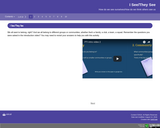
This is an activity for students to create their own I see/they see cartoon similar to what is in the book.
- Subject:
- Arts and Humanities
- Literature
- Material Type:
- Activity/Lab
- Author:
- Lisa Stone
- Date Added:
- 08/24/2018

This is an activity for students to create their own I see/they see cartoon similar to what is in the book.
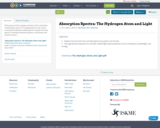
This group activity engages students in the calculation of absorption spectra. It is appropriate for any course covering the baseline mathematical concepts of atomic spectra, including chemistry, physics, astronomy, and related courses.
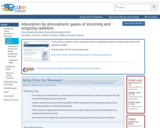
In this activity, students use the absorption spectra of greenhouse gases to explore the nature of the greenhouse effect.

Art can be found in everything, even ordinary objects. Artist David Huffman finds that abstraction is a great way to delve into the meaning and symbolism of everyday objects, like a basketball or a shoe. Find your own inspiration and create some abstract art -- it might have more meaning than you might think!
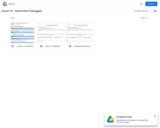
In this lesson, students will be presented with a project that they will decompose with their partners without having access to its code and without access to a computer. Students will work in teams to recreate the project shown in the following lesson.

This 90-minute module introduces students to the concept of Academic Integrity, guiding them in applying APA formatting to their work and recognizing academic dishonesty, along with its potential consequences. The module should be straightforward, user-friendly, clear, and intuitive in order to be accessible to all learners for whom this module is designed. This required module complements students' regular coursework, providing essential knowledge of academic integrity—an important step as they prepare for college-level study after completing their college-level, English Language course (an academic department offering preparatory courses for students with lower English proficiency before they begin their undergraduate or certificate programs).This module is designed for international students from diverse backgrounds in terms of work experience, education, ethnicity, and age. Prior knowledge of the subject is not necessary. There are no prerequisites, and students can participate from any location. The module includes live, synchronous sessions that require all students to be online simultaneously.
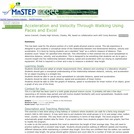
Using students' step length to understand the relationship between distance, speed and acceleration. Includes graphing of data and interpretation of graphs.
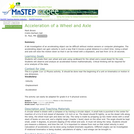
Students make a wheel and axle out of cardboard and a wooden dowel. It is rooled along a ramp made of parallel meter sticks, and the acceleration can be made small enough to make accurate measurements and calculations.
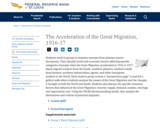
Students work in groups to examine excerpts from primary source documents. They identify social and economic factors affecting specific categories of people when the Great Migration accelerated in 1916 to 1917: black migrant workers from the South, southern planters, southern small-farm farmers, northern industrialists, agents, and white immigrant workers in the North. Each student group creates a "perspectives page" to post for a gallery walk where students analyze the causes of the Great Migration and the changes it brought to both the North and South. Students also discuss the specific economic factors that influenced the Great Migration: scarcity, supply, demand, surplus, shortage, and opportunity cost. Using the PACED decisionmaking model, they analyze the alternatives and criteria of potential migrants.
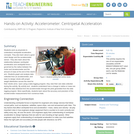
Students work as physicists to understand centripetal acceleration concepts. They also learn about a good robot design and the accelerometer sensor. They also learn about the relationship between centripetal acceleration and centripetal force governed by the radius between the motor and accelerometer and the amount of mass at the end of the robot's arm. Students graph and analyze data collected from an accelerometer, and learn to design robots with proper weight distribution across the robot for their robotic arms. Upon using a data logging program, they view their own data collected during the activity. By activity end , students understand how a change in radius or mass can affect the data obtained from the accelerometer through the plots generated from the data logging program. More specifically, students learn about the accuracy and precision of the accelerometer measurements from numerous trials.
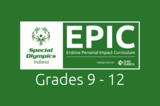
In this lesson, students will demonstrate their understanding of acceptance by developing a creative narrative that demonstrates the core theme of acceptance. The lesson includes a video clip, storyboard template, and rubric. This lesson is based on a video about the life of Carl Erskine, The Parallel book, and students’ research and perceptions of the concept.
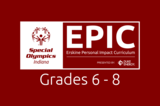
In this lesson, students learn about their classmates and teacher in a way that builds community and cohesiveness in the learning environment. Using the books, Playing for Change by Kelly Brown and The Parallel by Carl Erskine, as well as the Special Olympics video clip, Acceptance, students will discuss differences in the characters who were accepted and those who were not. In pulling these elements out of the plot, the students will then identify differences in themselves that possibly relate to others in the classroom.
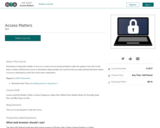
Information is inherently valuable. Access to it, or lack of access, has the potential to affect the quality of one’s life. In this lesson, students will learn how access to information shapes people’s lives and how they can make informed decisions related to access to information in their lives and in their communities.
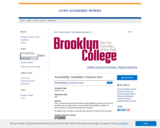
This is a treasure hunt game that simulates various disabilities and gives a sense of how frustrating non-accessible content can be for people with disabilities. Suitable for a general audience, no programming experience necessary.
An editable copy is also given, along with ideas about how to make it more accessible.
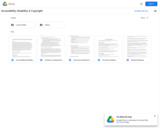
These materials are intended to be used both in graduate courses related to copyright or accessibility and by practitioners interested in learning more on the topic. Topics covered include the Chafee Amendment and how it has changed post-Marrakesh Treaty, the role of accessibility in the Authors Guild, Inc. v. HathiTrust decision, the importance of the Marrakesh Treaty for international efforts to make materials accessible across borders, and how licensing provisions can impact these various rights. The resources include videos explaining the key points of each topic, along with editable slide decks for those who wish to build on the existing materials, activities and options for assignments, recommended pre-class readings, discussion prompts, and related resources for those who want to learn more on the topics introduced in this OER module. There are also teaching notes for those interested in using the module in a class they are teaching.

This activity guides students through the evaluation of a website that they have created to see if it is accessible for users with disabilities. Students will simulate a number of different disabilities (e.g. visual impairments, color blindness, auditory impairments, motor impairments) to see if their website is accessible; they will also use automated W3 and WAVE tools to evaluate their sites. Students will consider the needs of users with disabilities by creating a persona and scenario of a user with disabilities interacting with their site. Finally, students will write up recommendations to change their site and implement the changes.
Comments
Although this activity can be used in isolation, it is intended to be part of a series guiding students towards the creation of a front-end of a website. The series (all published as OER) consist of:
a) Needfinding
b) Personas, Scenarios and Storyboards
c) Front-end Website Design and Development
d) Accessibility Evaluation
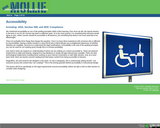
Accessibility in Online Learning

This is a computer-based activity in which students retrieve data from websites maintained by the US Geological Survey (USGS) and the National Weather Service (NWS), and then use that data to test different hypotheses regarding streamflow and precipitation. Students import data from web sites into a spreadsheet program where they can construct scatter plots and perform simple statistical tests. The activity has two components, the first focusing on relations between streamflow and drainage basin characteristics (drainage area, slope, precipitation), the second focusing on trends in annual precipitation at two locations in the USA: Burlington, VT, and Boulder, CO. As part of the second component, students conduct a statistical test to determine if the long-term trends in precipitation are significant.
(Note: this resource was added to OER Commons as part of a batch upload of over 2,200 records. If you notice an issue with the quality of the metadata, please let us know by using the 'report' button and we will flag it for consideration.)
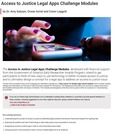
The Access to Justice Legal Apps Challenge Modules intend to get participants to think of new ways to use technology to better increase access to justice, and to ultimately design a concept for a legal app to address an access to justice issue.
The set of five modules are intended to operate as a “mini-course” for Ontario high-school students. Each module contains background information on the topic to help instructors prepare for the lessons. The background information has sources to support instructors and students delving further into topics of interest. The modules are designed so that they can be used in either an in-person or virtual learning environment.
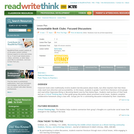
Students form literature circles, read "Esperanza Rising" or "Becoming Naomi Leon" by Pam MuĐoz Ryan, use a Critical Thinking Map to discuss social issues, and use a class wiki.